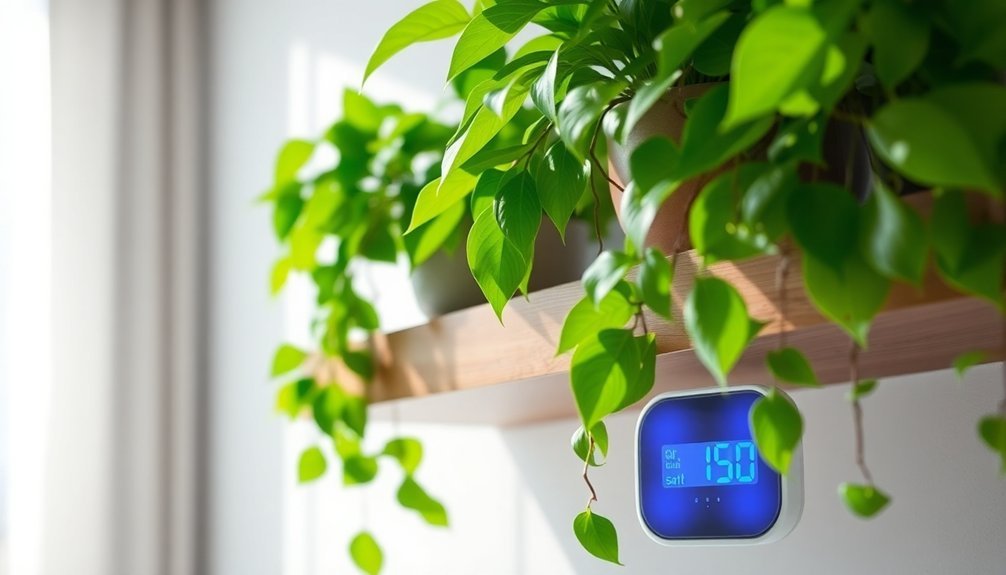You can use common houseplants as natural air quality detectors in your home. Plants like Peace Lilies, Spider Plants, and Boston Ferns respond visibly to air pollutants through yellowing leaves, brown tips, or unexpected wilting. Position these living sensors in high-traffic areas and monitor their appearance for early warning signs of poor air quality. By understanding your plants' signals and combining them with electronic monitors, you'll create a thorough air quality detection system.
Understanding Plant Responses to Air Pollutants

While plants can't verbally communicate their distress, they serve as natural indicators of air quality through their visible responses to pollutants. You'll notice signs like discolored leaves, stunted growth, or wilting when your plants are exposed to poor air conditions.
Your indoor plants, especially Peace Lilies and Spider Plants, actively combat air quality problems by absorbing volatile organic compounds (VOCs) from your living space. When exposed to pollutants, they'll release defensive compounds to protect themselves, showing you their resilience.
However, harmful substances like particulate matter and nitrogen dioxide can severely impact their ability to photosynthesize and grow properly. By monitoring these plant responses, you're gaining valuable insights into your environmental health, as your plants act as living sensors of air pollution in your home.
Best Air-Detecting Plants for Indoor Spaces
Since indoor air quality directly affects your health, choosing the right air-detecting plants can create a natural monitoring system for your living spaces.
These living air quality monitors respond to volatile organic compounds (VOCs) and other pollutants, making them excellent indicators of your indoor environment's health.
For the best indoor air quality, consider these powerful plant detectors:
- Spider Plants and Peace Lilies – actively absorb formaldehyde and benzene, showing stress when pollutant levels rise
- Boston Ferns – thrive in clean air but display browning leaves when detecting toxins
- Snake Plants – serve as natural indoor air quality monitors, especially at night
- Areca and Bamboo Palms – excel at filtering xylene and toluene, with leaves yellowing when air quality decreases
Position these natural sensors throughout your home for thorough air quality monitoring.
Signs Your Plants Are Warning About Poor Air Quality

Your indoor plants serve as nature's air quality monitors through visible leaf damage and growth patterns.
If you notice yellowing leaves, unusual spots, or discoloration, your plants might be alerting you to harmful pollutants like nitrogen dioxide or VOCs in your home's air.
Watch for sudden changes in growth rates or wilting, as these can signal poor air quality that needs immediate attention through better ventilation or air purification.
Leaf Damage Warning Signs
Plants serve as natural indicators of air quality, displaying visible signs of distress when exposed to pollutants.
Before investing in indoor air quality monitors, you can observe your plants for warning signs that suggest poor air quality in your home. These natural sensors can alert you to the presence of volatile organic compounds (VOCs) and other harmful pollutants through specific leaf damage patterns.
Watch for these tell-tale signs:
- Yellow spots or edges on leaves indicate exposure to nitrogen dioxide or ozone.
- Drooping or wilting leaves suggest your plants aren't getting enough clean air for proper photosynthesis.
- Brown leaf tips point to high levels of VOCs in your environment.
- Unexpected leaf drop or smaller-than-normal leaves signal elevated carbon dioxide levels.
These visual cues from your plants can help you decide when it's time to take action.
Plant Growth Pattern Changes
Beyond visible leaf damage, growth patterns offer clear signals about your home's air quality. When your indoor air quality deteriorates, you'll notice your plants developing unusual growth patterns that serve as natural air quality monitors.
Watch for stunted growth and unusually small leaves, which indicate your plants are struggling to photosynthesize in polluted conditions.
Look for changes in how your plants develop – if they're producing fewer flowers or fruits than usual, they may be diverting energy from reproduction to survive poor air conditions.
Volatile organic compounds (VOCs) can cause leaves to curl or wilt abnormally. You might also spot increased fungal issues like powdery mildew, as pollution weakens plant health and natural defenses.
These growth pattern changes act as early warning signs that your home's air needs attention.
Setting Up a Plant-Based Air Monitoring System
Establishing a plant-based air monitoring system combines nature's purifying power with modern technology for ideal indoor air quality.
You'll need air quality monitors like the Atmotube PRO to track volatile organic compounds (VOCs) and particulate matter, while plants naturally filter these pollutants. By monitoring the Air Quality Index (AQI) through your device's app, you can optimize your system's effectiveness.
To create an effective plant-based monitoring setup:
Strategic placement of air-purifying plants combined with digital monitoring creates a natural, effective system for maintaining optimal indoor air quality.
- Select proven air-purifying plants like spider plants, peace lilies, and snake plants
- Position plants strategically in high-circulation areas with adequate lighting
- Install portable air quality monitors to track VOC levels and particulates
- Check AQI readings regularly and adjust plant placement as needed
This combination can reduce airborne toxins by up to 87% within 24 hours, ensuring cleaner air throughout your home.
Combining Plants With Electronic Air Quality Sensors

Building on your plant-based monitoring foundation, integrating electronic air quality sensors with indoor greenery creates a powerful dual approach to maintaining clean air.
While plants like spider plants and peace lilies naturally filter out pollutants, air quality sensors provide real-time data on volatile organic compounds (VOCs) and other harmful substances your plants can't fully eliminate.
You'll benefit from this combination as the sensors track indoor air quality precisely, helping you determine when to supplement your plants with air purifiers.
The electronic monitors validate your plants' effectiveness while alerting you to unexpected pollution spikes.
This smart integration not only enhances your home's air purification system but also creates a more thorough approach to indoor air quality management, ensuring you're making informed decisions about your living environment's health.
Maintaining Your Living Air Quality Indicators
Your air quality sensors need regular calibration and testing to maintain their accuracy, so check the manufacturer's guidelines and perform these tasks on schedule.
Place your monitors at breathing height in commonly used areas, away from direct sunlight, drafts, and heat sources to get the most reliable readings.
Clean your sensor components monthly with compressed air and a soft brush to prevent dust buildup that could interfere with measurements.
Regular Calibration And Testing
While air quality sensors provide valuable insights into your home's atmosphere, their accuracy depends heavily on proper maintenance and regular calibration. Your indoor air quality monitors need consistent attention to maintain precise real-time air quality readings, guaranteeing you're getting reliable data about your living space.
To keep your monitors functioning effectively:
- Follow the manufacturer's calibration schedule – some devices offer automatic calibration while others need manual adjustment.
- Test your sensors against known air quality standards at least once every three months.
- Replace smart cartridges or sensing elements when recommended by the manufacturer.
- Document calibration dates and test results to track sensor performance over time.
Don't rely on uncalibrated readings, as sensor drift can provide misleading information about your indoor environment.
Regular maintenance helps guarantee you're making informed decisions about your home's air quality.
Optimal Placement For Accuracy
Beyond regular calibration, the strategic placement of air quality monitors plays a defining role in measurement accuracy. You'll want to position your indoor air quality sensors at breathing height (3-5 feet) to capture the air you're actually inhaling. Place monitors near potential pollution sources while avoiding windows and ventilation systems that could affect readings.
| Location | What to Monitor |
|---|---|
| Kitchen | VOCs from cooking |
| Garage | Vehicle emissions |
| Living Room | General air quality |
| Bedroom | Nighttime exposure |
For ideal placement, consider using multiple air quality monitors throughout your home to track volatile organic compounds (VOCs) and other pollutants. Each room may have different air quality challenges, so strategic positioning helps you identify specific problem areas and take targeted action to improve your indoor environment.
Clean Sensor Components Monthly
Three essential maintenance steps will keep your air quality sensors operating at peak performance.
Regular cleaning of sensor components prevents dust and debris from interfering with measurement accuracy, while monthly maintenance guarantees reliable data collection.
By following proper care procedures, you'll extend your air quality monitor's lifespan and maintain precise readings.
To properly clean your sensor components:
- Gently wipe the exterior with a soft, lint-free cloth
- Check for and remove any airflow obstructions around detection areas
- Use appropriate cleaning solutions that won't damage sensitive parts
- Replace smart cartridges according to manufacturer recommendations
Make sensor maintenance a monthly priority to guarantee your air quality monitor continues providing accurate readings.
This simple routine helps you make informed decisions about your indoor air quality while protecting your investment in clean air technology.
Seasonal Changes in Plant Air Detection Abilities
As seasons change throughout the year, plants' natural abilities to detect and filter air pollutants fluctuate considerably. You'll notice your indoor plants perform best during spring and summer when their metabolic processes are most active. During these warmer months, they're particularly effective at filtering volatile organic compounds (VOCs) and other airborne pollutants.
| Season | Plant Activity | Air Detection Ability |
|---|---|---|
| Spring | High growth | Excellent |
| Summer | Peak metabolism | Maximum |
| Fall | Slowing down | Moderate |
| Winter | Dormancy | Minimal |
| Early spring | Awakening | Increasing |
Like urban vegetation outdoors, your indoor plants work harder to clean air during their active growth phases. However, you'll need to adjust your expectations during autumn and winter, when their natural sensing and filtering capabilities decrease due to reduced metabolic activity and dormancy periods.
Frequently Asked Questions
What Sensor Detects Air Pollution?
You'll find air quality sensors that detect PM2.5, PM10, VOCs, and CO2. They use laser light scattering and electrochemical methods to measure pollutants, giving you real-time data about your air quality.
How Can I Measure Air Pollution at Home?
You can measure air pollution at home using portable air quality monitors like Atmotube PRO. These devices detect fine particles and VOCs, connect to your smartphone, and provide real-time alerts about dangerous pollution levels.
How Do You Detect Indoor Air Pollution?
You can detect indoor air pollution using air quality monitors that measure PM2.5, VOCs, temperature, and humidity. These devices give you real-time readings and alerts when pollution levels become concerning.
How Do You Test for Air Pollution in Your Home?
You can test home air pollution using portable air quality monitors that detect fine particles and VOCs. They'll measure AQI, PM2.5, and CO2 levels, sending real-time alerts to your smartphone through connected apps.
In Summary
You've discovered how to create your own natural air quality monitoring system using plants as living sensors alongside modern technology. By watching for key warning signs in your chosen plant species and understanding seasonal variations, you'll stay informed about your indoor air quality. Remember to maintain your plants properly and cross-reference their signals with electronic sensors for the most accurate results. Now you're ready to breathe easier with nature's help.





Leave a Reply